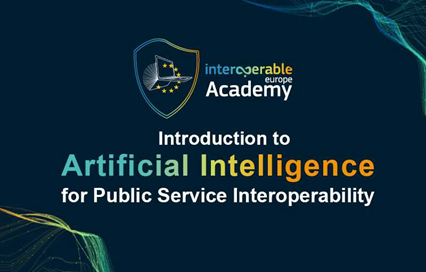AI for interoperability
Artificial Intelligence (AI) stands as one of the most transformative global technology trends of the 21st century. While its conceptual roots trace back several decades, the past couple of years have witnessed an unprecedented surge in its adoption and application across all industries.
In the face of this transformative era, the EU AI Act represents the first attempt to regulate AI technologies, to ensure better conditions for their development and use across the European Union. This legal framework sets Europe apart from other territories by embracing the technological opportunity but also addressing its risks.
In the public sector too, AI is becoming an essential tool for better structuring, curating, standardising and processing data. During his opening speech at the SEMIC 2023 Conference in Madrid, Siim Sikkut stated that "AI will be the future of government". If Europe wants this prediction to become a reality, then interoperability needs to be one of its strategic enablers.
In this context, the ‘AI for Interoperability’ (AI4OP) initiative explores opportunities to create synergies between AI and semantics, ultimately improving interoperability within and across public organisations in Europe. This is also where SEMIC plays a leading role by empowering interoperability through AI-driven solutions and leveraging advanced AI models to bridge data silos, foster collaboration, and drive innovation.
AI & SEMIC in practice
SEMIC invests in projects featuring AI as a solution for semantic interoperability. The objective is to study and test practical applications of AI systems for the benefit of the community. Our services can be categorised under three pillars: the Knowledge Hub, Pilots and Specifications. On the right you can find a video explaining the development and functionalities of one of SEMIC's pilot: an AI augmented chatbot for data modelling!
Comprehensive research to investigate various aspects of AI, interoperability, and advanced technologies.
- SEMIC completed a study in the field of Generative AI. Our team carried-out an analysis on the impact of domain adaptation on two state-of-the-art models:
- How does the retaining and fine-tuning of BERT on tourism data impact the quality of pledge clustering?
- How does the retaining and fine-tuning of RoBERTa on tourism data impact the quality of pledge clustering?
Results and insights of this study can be found on GitHub.
Pilot projects to demonstrate how AI can improve semantic solutions through automation and data insights; or facilitate semantic interoperability with applicable standards.
- Knowledge extraction - pledge analysis tool: In collaboration with DG GROW, SEMIC developed an AI tool to gain valuable insights from a large set of pledges on the Transition Pathway for Tourism. For example, an AI model was employed to extract and visualise the key topics and actions addressed by these pledges. More information about this PoC can be found on GitHub.
- Data modelling chatbot: To support the work of data modellers, SEMIC developed a prototype of RAG chatbot that can suggest classes, relations, and properties to be added to a data model.
MLDCAT-AP is a semantic model in the field of machine learning. Its objective is to extend the use of DCAT-AP. It facilitates standardised descriptions of a machine learning process, together with their datasets, quality measured on the datasets and citing papers. The model was developed in collaboration with OpenML.
Feedback, issues or thoughts can be shared via the originated GitHub.

Responsible use of AI within semantic interoperability
The practical application of AI implies risks such as errors, bias, discrimination or lack of transparency. Therefore, AI applications should be used with alertness.
The European Commission has developed the AI Strategy, approved the AI Act and has been following Ethics Guidelines for Trustworthy AI since 2019.
The purpose behind these efforts is to minimise the potential risks associated with utilising AI, while simultaneously maximising the value that can be derived from this rapidly advancing technology.
In the context of developing more responsible AI systems, semantic interoperability also has an important role to play. By promoting the use of standardised data formats, cleaner datasets, and better metadata, SEMIC has a direct impact on the quality of the training data which allows AI systems to generate more reliable and accurate outcomes.
Leverage your own AI Capabilities!
SEMIC and the EU Academy launched a new training: Introduction to AI for Public Service Interoperability.
Discover the exciting world of Artificial Intelligence and its role in supporting interoperable public services! In this course, you will delve into the fundamentals of AI and explore its various components. Gain insights into the legal and policy contexts surrounding AI, and learn about the methods that enable interoperability through AI. Uncover the challenges that come with this field and explore real-life examples of AI applications.
Join us on this educational journey and unlock the potential of AI for seamless and efficient public services.
This training tackles the following topics:
- Introduction to AI
- Introduction to Interoperability
- AI supporting Interoperability in public administration in MS
- Conclusion and next steps


